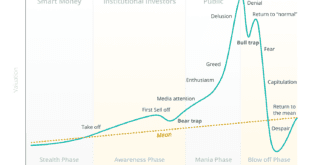The Dow 30 continues to be presented and endorsed as a true reflection of the health of the economy yet it is anything but. The truth of the matter is that it’s deceptive in what it purports to represent. The manipulation of the performance of the Dow 30 has been going on since 1928 and it was further denigrated on September 23rd with a 3 constituent swap which will, in effect, assure that it continues to rise in the long term. This article outlines the extent of this reconfiguring (and the resultant change in the Dow Divisor) and the extent to which doing so will affect the performance of the index. Read on. The effect is significant.
of the economy yet it is anything but. The truth of the matter is that it’s deceptive in what it purports to represent. The manipulation of the performance of the Dow 30 has been going on since 1928 and it was further denigrated on September 23rd with a 3 constituent swap which will, in effect, assure that it continues to rise in the long term. This article outlines the extent of this reconfiguring (and the resultant change in the Dow Divisor) and the extent to which doing so will affect the performance of the index. Read on. The effect is significant.
So write Ronald Hendrickx and Wim Grommen in an exclusive English language version of their original article which has been translated and edited, with permission, by Lorimer Wilson, editor of www.munKNEE.com, and the FREE Market Intelligence Report newsletter (sample here).
Hendrickx and Grommen go on to say:
It is becoming more and more meaningless to compare the Dow 30’s performance from one period of time to another. Why? Because continuing replacement of mature constituent companies with lower priced stocks (i.e. losers out) with companies with higher priced stocks with anticipated greater future growth prospects for price appreciation (i.e. winners in), as it happened again on September 23rd, is nothing short of injecting the index with growth hormones making any performance comparison over the years of its existence invalid.
The Dow 30 Index Is Deceptive
An index is calculated on the basis of a basket of shares and a set formula that is used as the criteria for arriving at the number of points of the index. However, in the case of the Dow 30, the basket of shares change frequently and the formula on which the value of the index is calculated keeps changing.
Over the past 10 years, for example, 40% of the constituents of the Dow 30 have changed and a full 67% have changed over the past 16 years. In effect, whenever the Dow 30 undergoes a change in constituents it makes it impossible to compare its performance from one year to the next on a consistent basis. In spite of that, however, the Dow 30 continues to be presented and endorsed as a true reflection of the health of the economy yet it is anything but. The truth of the matter is that the Dow 30 is deceptive in what it purports to represent.
The Swap
Generally speaking, the companies that are removed from the list of Dow 30 constituents are in a stabilization or degeneration phase and companies in a take-off or acceleration phase are added. This greatly increases the chance that the index will rise rather than go down. This is obvious, especially when this is done during the acceleration phase of a transition.
The abovementioned phases are exemplified in the deletions and additions of constituents to the Dow 30 this week.
The following 3 mature constituents of the Dow 30 that have been removed are:
-
Hewlett- Packard Co.
-
Bank of America Inc.
-
Alcoa Inc.
-
the average share price of the stocks of the above companies is approximately $15/share (sum total value of approx. $45)
-
The 3 replacement companies with anticipated greater future prospects for price appreciation that have been added are:
-
Goldman Sachs Group Inc.
-
Nike Inc.
-
Visa Inc.
-
the average share price of the stocks of the above companies is approximately $145/share (sum total value of $434)
-
The Dow Divisor
With every change in the set of shares used to calculate the number of points the formula to calculate its “true” value also changes. This is deemed necessary to ensure that the sum total value of the previous basket of constituents matches the value of the new basket of constituents thereby allowing for a continuous smooth progression on the chart for the Dow. This is accomplished by the application of a mathematical calculation called the Dow Divisor.
The Dow Divisor ensures that the value of the Dow with the new shares is the same as the value of the Dow 30 with the old shares but this is effective only in the short term. In the longer term the profits of the higher priced stocks are greater/stronger than those of the weaker stocks that they replaced resulting in a disproportionate positive influence on the performance of the Dow 30 as a whole.
The Dow 30 is calculated by dividing the sum total of the 30 constituents’ share prices by the Dow Divisor . On September 18, the Dow 30 closed at 15,677 points . The Dow Divisor currently has a value of 0.130216081 . This means that the total value of the 30 shares on that day was $2,041 (15,677 x 0.130216081 = $2,041).
The Dow Divisor Adjustment
As mentioned above, the $45 sum total closing trading value (Sept. 18th) of the 3 stocks being removed from the list of constituents are being replaced by 3 companies with stock values amounting to approximately $434 or 9.6 times greater as of Sept. 18th. This means that the new sum of the 30 stocks will have a value of $2,430 ( 2,041 – 45 + 434 ) and, therefore, the Dow Divisor will be adjusted from the current 0.130216081 to 0.155004146 to get back to the original 15,677 index points (15,677 x 0.155004146 = $2,430). These aforementioned numbers are approximate as the actual change will be marginally different when the closing prices of the 6 stocks involved and the Dow 30 of last Friday, September 20th are used.
Significance of the Swap
Given the explanation above let’s take a look at the implications of what this swap in constituents means for the value of the Dow 30 as a whole.
-
Prior to Sept. 23rd, had the shares of the 3 companies being removed increased by 10% each in price, the Dow 30 would have increased by 34.56 points in total (10% x 45 divided by 0.130216081 = 34.56 points) assuming there was no change in the price of the other 27 stocks.
-
As of September 23rd, were the shares of the 3 companies being added to increase 10% each in price, the Dow 30 would contribute 280 points to the rise of the Dow 30 (10% x 434 divided by 0.155004146 = 279.99) or 8.1 times more points.
Bottom Line:
- The 3 stocks being removed had a 2.2% influence ($45 as a % of $2,041) on the performance of the overall Dow 30 Index
- The addition of the 3 new stocks to the list of constituents will have a 17.86% ($434 as a % of $2,430) influence on the performance of the Dow or 8.1 times more so than the companies removed.
The replacement of Hewlett Packard, Bank of America and Alcoa as constituents in the Dow 30 with Goldman Sachs, Nike and Visa has put the index on steroids which more or less assures greater appreciation of the Dow than would otherwise have been possible.
Talk about “juicing” an index! Talk about blatant index manipulation! Talk about comparing apples and oranges! This is it in spades!
The DOWDIVISOR30 campaign will start shortly and is intended to convince the people responsible for the composition of the Dow Jones – a number of journalists employed by the Wall Street Journal and S & P Dow Jones Indices LLC, a subsidiary of The McGraw-Hill Companies, the owner of the Dow Jones Index – to restore the Dow Divisor in the formula used to calculate the Dow Jones to its original value of 30.
A petition is being drawn up which will be distributed worldwide requesting that President Obama’s administration exert pressure on the above mentioned entities to carry out this change in the Dow Jones formula. As soon as the list of friends has achieved a respectable size, the campaign will officially start.
Related Article:
 munKNEE.com Your Key to Making Money
munKNEE.com Your Key to Making Money




Ever more manipulation of the basic figures many use to judge the condition of the USA..
Expect to see PM’s zoom upward as more investors realize that the system is rigged by the Fed to support the Big Banks instead of the citizens of the USA.